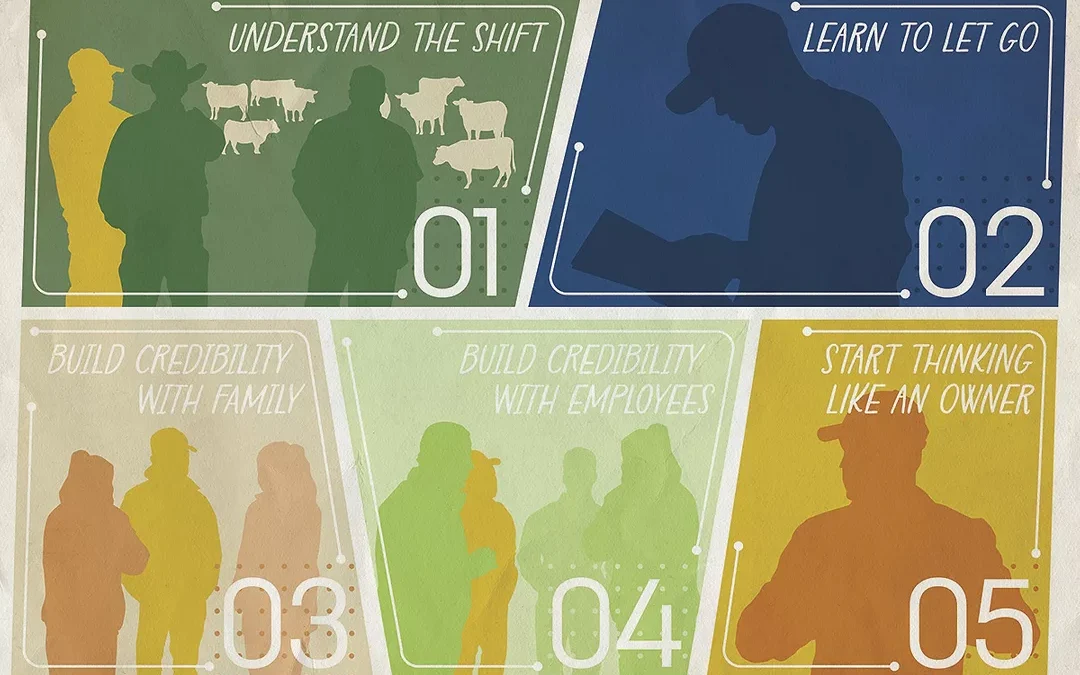From Worker to Leader: What Next-Gen Farmers Need to Know
Shifting from employee to leader may not be as easy as you think. Follow these steps to help your transition into being the best leader you can be.
You’ve been putting in the hours. You show up before dawn, you work, you haul, you fix, you hustle. That’s how every farm leader starts – by proving they can do the work.
But at some point, the question changes. You’ve probably asked yourself:
“How do I stop being just the worker and start being seen as a leader?”
It’s a great question – and it means you’re ready for the next step. Let’s walk through what leadership on the farm really looks like, and what you need to do to earn it.
Step one: Understand the shift
Right now, most of your value might come from being the person who can do. You know how to run equipment, handle livestock and jump in wherever you’re needed. That’s essential – but leadership is about something different.
Leaders don’t just ask “What needs to be done today?” They ask “What decisions today will shape the farm for the next five, 10 or 20 years?”
This is the shift you need to make – from doer to decision-maker.
That means you’ll need to:
-
- Start paying attention to numbers and not just acres or herd size.
- Think about systems that prevent problems, not just fixing things when they break.
- Step back enough from the day-to-day so you can see where the farm needs to go long term.
It’s not easy. It feels weird to step out of the tractor to sit in on a banker meeting. But those moments are where you begin to earn your seat at the decision-making table.
Step two: Learn to let go of ‘I’ll just do it’
One of the biggest traps you’ll face is this: You’re probably faster, stronger or more skilled at certain jobs than others on the farm. It’s tempting to say “Forget it, I’ll just do it myself.”
But here’s the problem: If you always do the work, you’ll never step into leadership.
Leaders train people. They delegate. They give others the room to learn, even when mistakes happen. If your younger brother dents the skid loader bucket or your employee stacks hay the “wrong” way, resist the urge to take over. Your role is to help them improve, not prove that you can do it better.
This is one of the toughest habits to break – but it’s the only way to grow your capacity as a leader.
Step three: Build credibility with family
Here’s some straight talk: Just because you’re family doesn’t mean you automatically get respect. Your dad, mom, siblings or cousins will watch to see if you’re serious about leadership.
You build credibility in a few key ways:
-
- Show consistency. Don’t volunteer for responsibility and then drop the ball. If you take on the books, do them right. If you push for family meetings, be the one prepared with notes.
- Communicate clearly. Don’t just assume they know your ideas. Share them openly and reciprocate by listening to ideas that others have.
- Respect the senior generation. Even if you think you’ve got a better way, honor the years of experience they bring. You don’t have to agree with everything, but you do need to show respect.
- Be transparent. If you’re handling money, leases or contracts, keep it in the open. Secrets destroy trust fast.
Remember, your family has seen you at every stage of life. You’re asking them to see you differently now, as someone who can lead. You’ll need to show them with your actions, not just your words.
Step four: Build credibility with employees
If your farm has employees, they’ll look to you differently than family does. They want to know if you’re someone worth following.
Here’s how you prove it:
-
- Work alongside them. Don’t disappear into an office all the time. Show that you understand the work they do.
- Be fair. Hold yourself, your siblings and your friends to the same standards as everyone else. Nothing kills credibility like favoritism.
- Give clear instructions. Don’t be vague. Be specific about what you expect.
- Invest in them. Pay fairly, provide training and give them a chance to grow. When they see you care about their success, they’ll care more about yours.
Employees don’t follow titles. They follow people they respect.
Step five: Start thinking like an owner
You may not own the business yet, but if you want to lead, you have to start thinking like you do.
Ask yourself questions like:
-
- If this were my money, would I make this purchase?
- If this were my land, how would I protect it for the long run?
- If I were hiring, what kind of person would I want on this team?
Thinking like an owner helps you earn respect from both the current owners and the next generation of workers. It shows you’re not just punching the clock – you’re invested in the farm’s future.
The payoff
So what does leadership on the farm really look like for you? It looks like this:
-
- You still work hard, but you don’t measure your value only in hours or acres.
- You carve out time to make decisions that will matter years down the road.
- You earn credibility by showing up, being consistent and treating people fairly.
- You stop trying to do it all yourself and start building a team that can carry the load together.
This transition won’t happen overnight. People won’t hand you credibility just because you asked for it. You’ll need to show it day in and day out. But here’s the reward: When you step into leadership, you don’t just run a farm – you shape a legacy.
If you’re asking how to move from worker to leader, you’re already on the right path. Keep doing the work, but start making the shift: Think bigger, act consistently, build trust and make decisions that will outlast today’s chores.
That’s what your family, your employees and your farm need from you – so step up and lead like the future depends on it, because it does.
This article also found here on AgProud/Progressive Cattle – October 2025

Article by Rena Striegel, President of Transition Point Business Advisors
Transition Point Business Advisors as has a program entitled, The DIRTT Project, which gives the American Farmer full control of their succession plan from beginning to end. Go to our website to learn more about The DIRTT Project.

